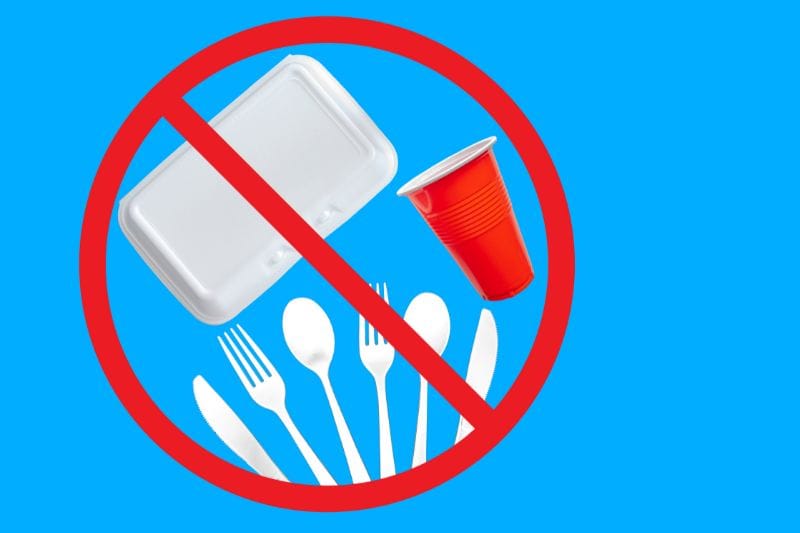We all know that climate change, global warming, depletion of the ozone layer, and resource depletion are real, and their impact on human and animal lives can be devastating.
As such, it’s high time for us to adopt actions for sustainable living that can help us reduce our carbon footprint or environmental impact by altering our lifestyle.
But in what way can we make our impact felt on our planet? Well, this article has curated some of the easy-yet-effective sustainable ways to make planet Earth much better, so read to the end.
What is Sustainable Living?
Sustainable living is the practice of reducing your demand for natural resources by making sure you replace what you use to the best of your ability.
Sometimes, that can mean not choosing to consume a product that is made using practices that don’t promote sustainability, and sometimes, it means changing how you do things so that you start becoming more of an active part of the cycle of life.
If it can’t be reduced, reused, repaired, rebuilt, refurbished, refinished, resold, recycled, or composted, then it should be restricted, redesigned or removed from production
~ Pete Seeger
Simple measures like using public transportation more often, reducing energy consumption, and becoming more eco-friendly can reduce your environmental impact and make this planet a clean and safe place.
According to Wikipedia;
“Sustainable living is a lifestyle that attempts to reduce an individual’s or society’s use of the Earth’s natural resources and personal resources. Practitioners of sustainable living often attempt to reduce their carbon footprint by altering methods of transportation, energy consumption, and diet.
Kahle, Gurel-Atay, and Armonk (2014) meanwhile define sustainability as,
Proponents of sustainable living aim to conduct their lives in ways consistent with sustainability, in natural balance, and respectful of humanity’s symbiotic relationship with the Earth’s natural ecology and cycles. The practice and general philosophy of ecological living is highly interrelated with the overall principles of sustainable development.“
25+ Ultimate Ideas to Practice Sustainable Living
Want to start practicing sustainable living? It is easier than you think. Here are 25+ quick and easy ideas to live a sustainable life.

1. Become a Member of a Community Garden
It isn’t just about growing your own food. Being a community garden member helps promote sustainable living in your area. Gardens create green spaces, and the garden waste can be mulched and returned to support healthy soil.
Green spaces aren’t just important for your state of mind; they can play an important role in offsetting carbon emissions in urban areas.

2. Practice Minimalism
Minimalism doesn’t mean living without anything. It means ensuring that everything you own and use is put to its maximum purpose and that you cut out anything unnecessary.
This applies to waste materials as well. With a minimalist lifestyle, you will recycle more, use less, and be more mindful of the items you support so that sustainability is emphasized.

3. Change the Lights in Your House
By changing the lighting in your home from traditional light bulbs to CFL, using skylights and more natural light, you will reduce your demand for energy resources significantly.
Using longer-lasting, energy-efficient light sources also substantially reduces the amount of electronic waste going into landfills.

4. Become More Efficient with Your Errands
You don’t have to buy a hybrid vehicle to reduce reliance on fossil fuels. By becoming more efficient with your errands, you can create a sustainable living system that reduces the number of natural resources you consume.
This may mean walking or biking wherever you need to be, assuming that the route allows you to do so safely. Commuting instead of driving is also helpful since this reduces the number of vehicles running at a given time.

5. Start Using Natural Cleaners
Take an hour or so to research some homemade options for natural cleaners. Vinegar and water can clean most surfaces, while the saponin from quinoa is a natural laundry detergent.
Using natural cleaners reduces the amount of plastic packaging being made and the number of chemicals being introduced to the water system.

6. Spend More Time Reading and Playing Games
You might be wondering how this can be a part of sustainable living. Playing, reading, or singing does not need energy.
By reducing your reliance on entertainment forms that require energy and natural resources, you can help to reduce the demand and drain on them.

7. Try to Get on a More Natural Sleep Schedule
Getting on a natural sleep schedule means becoming more attuned to the natural light in the day.
Not only is this better for your health, but it will also begin to lessen the power you use while you are up.

8. Reduce, Reuse and Recycle
Reduce your need to buy new products. If there is less waste, there is less to recycle or reuse. Learning to reuse items or repurpose them for a different use than intended is essential in the waste hierarchy.
Recycle old glass bottles or aluminum cans. Keep a recycle bin at your home and make more trips to the recycling station than to the landfill.

9. Walk, Bike, or Carpool to Work
The less personal use of your car you do, the more you and the environment will benefit. Sustainable living advocates for sustainability by reducing pollution and minimizing the consumption of natural resources, and that involves doing more walking, biking, and carpooling than using your own personal means.
Plus, walking or biking to work will even improve your health and reduce the strain on public health resources. Just ensure that the route you plan to walk or bike on is safe for pedestrians and bikers.
Even car-pooling assists sustainability by providing an increased social outlet that can improve the quality of life. Science has found a direct connection between your quality of life and the sustainability of life you will choose to lead.
Apart from being good for your health, carpooling helps reduce the number of vehicles at a given time, which may lead to lesser overall emissions for transportation and, of course, lessen the traffic jams.

10. Unplug Your Devices When Not in Use
How many times have you switched your television off using a remote and failed to unplug it from the power source? Well, if you’re planning to lead a more sustainable life, then you’ll need to take the extra step and unplug it from the energy source.
Maybe you don’t know it, but most electronic devices keep on drawing electricity even when they’re off. So, to reduce energy usage, simply pull the plug when not in use. It will help you to save energy and minimize your monthly electricity bill.

11. Buy a Right-Sized House
Sustainable living practitioners conduct their lives in ways consistent with sustainability. And among the many ways that promote sustainability is buying a smaller house.
A house just the right size for your needs will consume less energy than a bigger one. Consequently, you will spend less on lighting, furniture, and overall furnishing.
You can even purchase items from thrift stores and donate them again when they’re no longer needed. Make use of green home-building ideas and techniques when building a new home.

12. Use Daylight as Much as Possible
Sunlight is free and doesn’t cost anything. Using sunlight during the day helps reduce dependence on fossil fuels to produce electricity and maximizes the lifespan of your bulbs and tube lights.

13. Stop Unwanted Mail, Both Paper and Electronic
Save natural resources by opting out of unwanted mailings and simplify your life. Various sites offer free services to opt out of catalogs, coupons, credit card offers, phone books, circulars, and more.
It helps reduce clutter, protect privacy, and save the environment. This also applies to emails since the more data is stored in your email account, the more energy your email provider consumes to keep that data.

14. Practice Keeping a “Zero Energy Balance” Budget
Zero energy balance occurs when an individual’s energy intake, typically through food, matches their energy expenditure, ensuring no excess or deficit of energy is stored in the body.
It is really the core of all sustainable living. If you practice keeping a budget with a zero energy balance, you will be surprised how your consumption habits will change and reduce your imprint on the world.

15. Change Your Washing Habits
This one is important to attain sustainable living. We wash everything too much.
Not only has science discovered that our over-emphasis on being clean has reduced our natural immune resistance to diseases (which require exposure to bacteria to develop), but each person wastes tremendous amounts of water when they bathe, wash dishes, or do laundry.
Practice taking quicker showers, washing dishes in a sink of water, and then rinsing them and cutting down on the amount of laundry you do.

16. Choose Renewable Energy
Choosing renewable energy over fossil fuels is a great way to stop climate change and do your part in making things happen. Install solar panels for solar water heating.
Explore options for getting tax credits from the government. Speak to your utility provider if there is any way to add clean power to the grid to offset your carbon footprint.

17. Buy Products with Less or Sustainable Packaging
Whenever you go out shopping, always buy products with less packaging. The excess packaging on the stuff goes in your dustbin and eventually landfills. That not only further contaminates the environment but also poses serious health effects to humans and animals.
Another way you can do away with packaging is by bringing your own bags when shopping. That way, stores don’t have to provide you with plastic/paper bags that are likely to contaminate oceans and soils.

18. Ditch Plastic as Much as is Possible
Plastic never goes away. It takes millions of years for plastic to decompose. That means any plastic that has ever been produced persists somewhere within our environment.
This material can be found swirling on the ocean’s surfaces. It badly affects marine life. Every year a large number of mammals, seals, and seabirds are killed after ingesting plastic or getting tangled up in it.
It’s time for all of us to switch to reusable bags when we shop and ditch one-time-use plastic water bottles.

19. Give Single-Use Items a Wide Berth
We encounter single-use items in our day-to-day life. Single-use items like plastic straws, toilet paper, paper towels, plastic grocery bags, and plastic cutlery are a big threat to our environment.
Among the ways you can skip single-use items is to opt out of disposable utensils when ordering food online and buy things in bulk so that you get what you need with less packaging.
You may not be able to remove all the items but can surely cut down the use of some of these items.

20. Replace All Possible Disposables
Identify disposable products that are possible to replace with reusable ones. The list includes towels, shopping bags, razors, cups, plates, food storage, diapers, batteries, writing pens, ink cartridges, coffee filters, furnace or air conditioner filters, etc.
You may buy refurbished, local, or used products where possible.

21. Carry Your Own Reusable Shopping Bags
Whenever you go to a local market or a nearby mall for shopping, always carry your reusable shopping bags. It’s never a shame to carry a reusable bag with you if you care for the environment and want a more sustainable lifestyle.
In fact, bringing your own packaging with you when shopping shows how much you care for the environment and how eager you are to live a sustainable life. Carrying your own shopping bag lets you shop without needing to store your shopping items in several different plastic/paper containers.

22. Use Sustainable Technologies
Make use of rechargeable batteries. Switch to a sustainable search engine like Ecosia. They run 100% on renewable energy and use some of their profits to plant trees.
You can also consider using solar energy chargers and donating your old devices to poor kids or NGOs. It will mean they won’t have to buy new ones, which will reduce what eventually goes into landfills. Dispose of your electronic items to local waste recycling programs.

23. Observe an Eco-Sabbath
A single day or afternoon or at least an hour a week, set your own time and give yourself and the planet a break. During that period don’t buy anything, don’t use any machines, don’t switch electrical items, don’t cook, don’t answer your phone, which means don’t use any resources.
It may look like a silly initiative, but every hour a week cuts your carbon emissions by 0.6 percent annually. If you commit to four hours a week, that’s 2.4 percent, and for a whole day, each week’s impact will be 14.4 percent a year.

24. Share with Friends or Borrow
Things such as books, magazines, movies, games, and newspapers can be easily shared between friends and neighbors.
In the same way, if you need something temporarily, ask if a friend or neighbor would lend it to you. Sharing and borrowing can easily go side by side. It will reduce the potential clutter in our homes and cut expenses.

25. Have a Tree-Free Home
Replace disposable paper napkins and towels with cloth napkins/towels. You can even use your old t-shirts like towels, napkins, mops, dusters, and many more options you need. Just wash and reuse.
Install a bidet and supplement with bleach-free, 100% post-consumer recycled toilet paper.
Reuse envelopes, wrappers, the front of gift cards or postcards, and any other paper materials you receive by converting them to notepads or message books to take notes or for leaving a message, making a grocery list, or making your cards.
Switch to a digital organizer for tracking to-do’s and grocery lists or use handmade papers.
Read books, magazines, and newspapers from the local library or online (many have email newsletters).
Print documents on a once-used paper, on both sides, or on bleach-free recycled paper.

26. Remodeling With Some Green Building Choices
There are some eco-friendly flooring materials like straw bale, bamboo, true (natural) linoleum, previously used wood(vintage or timber works), and even cob.
Other ways are eco-cement, energy-efficient windows, green insulation, solar-powered water heaters, energy-star appliances, and lowest-flow toilets.

27. Make Your Own
These days DIY is highly popular on the internet. Make use of it. Make your own non-toxic homemade cleaning products, natural body products, personal care products, and other utility products.

28. Finally Your Food
“The world is producing the wrong kind of food, by a process that leaves millions of people landless, homeless, cashless, and unable to feed themselves.”
– Anita Roddick
A vegan diet is a powerful way to improve your health, help ensure everyone has enough to eat, and help protect our environment. Therefore, switch to an animal-free diet.
Livestock is one of the largest sources of greenhouse gases accounting for 18% of the global greenhouse gas emissions measured in CO2 equivalents.
Conclusion
To sum up, there are several ways that we can make our own contribution to a better world, beginning with living a sustainable lifestyle. Not only does a sustainable lifestyle have less impact on the environment, but it also involves practices that are good for both the environment and health and encourage others to be environmentally conscious as well.






